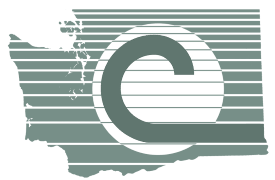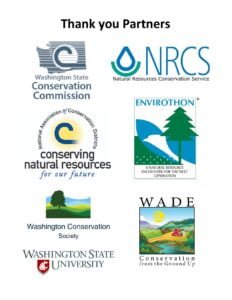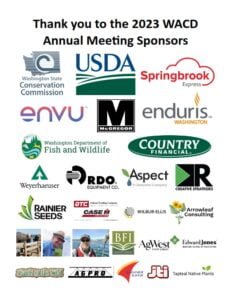About WACD
WACD supports conservation districts in their work with government, partner organizations, businesses, private landowners and working lands managers to implement best management practices, to utilize innovative equipment and materials, to provide technical assistance, and to develop expertise to address resource issues.
WACD, through the work of its leadership, professional staff and its members, provides support to conservation districts in the areas of technical capacity development, leadership training, government relations, strategic planning, governance, conservation funding, legislation and information sharing. WACD’s initiatives allow conservation districts to use their collective strengths to accomplish what cannot be done individually.
What is a Conservation District?
Conservation districts work with landowners on a voluntary basis, providing incentive-based conservation help on private lands. Why? Because private land management is key to conserving Washington State’s renewable natural resources. Conservation districts are a unique form of non-regulatory government, matching local needs with technical and financial resources to help landowners solve on-the-ground conservation issues. Two-hundred and twenty five (225) Washington citizens devote their time, energy and talent in providing local governance of Washington’s 45 conservation districts! Chapter 89.08 Revised Code of Washington authorizes conservation districts and provides the framework for their activities.
Learn more by contacting your local conservation district office. For a map of the districts by geographical area, follow this link – Find Your District.
Partners and Sponsors
The vitality of our partnerships and the broad support we receive from sponsors enables WACD to serve as the voice of Washington State’s 45 conservation districts.
Partners
Area Associations
Each Washington State conservation district belongs to an area association. At least once a year, each area association meets to discuss conservation issues and to seek consensus on matters to bring to the annual statewide meeting of WACD.
Each area association has its own set of governing documents.
- Northeast Area Association Bylaws (amended October, 2009)
- North Central Area Association Bylaws (amended October, 2012)
- Northwest Area Association Bylaws (amended October, 2018)
- Southeast Area Association Bylaws (amended November, 2007)
- South Central Area Association Bylaws (amended October, 2011)
- Southwest Area Association Bylaws (amended October, 1995)
The Three Regions of Washington
The Washington State Conservation Commission elects a conservation district supervisor from the eastern, central, and western parts of the state based on our geographic organizational structure. A map of these areas is available online in PDF format: WACD_Areas-Map-Dec-2016
Eastern Washington
The Northeast Area Association of Conservation Districts and the Southeast Area Association of Conservation Districts cover the eastern Washington region. The climate in this region is marked by dry summers and cold, crisp winters. The northern portion of this region is forested. Remnant pockets of drought-tolerant trees survive in valleys and pockets in the southern part of this region, where low summer rainfall and drying winds limit the success of most trees and shrubs. Some of the most productive soils exist in southeast Washington, where despite low annual rainfall, local farms produce large quantities of food. The Eastern Washington Regional Conservation Commission Member is currently Larry Cochran of Palouse CD.
Central Washington
The North-Central Area Association of Conservation Districts and the South-Central Area Association of Conservation Districts cover the central Washington region, bordered to the east by the eastern Washington region and to the west by the crest of the Cascade Mountain Range. The climate in this region is marked by dry summers and cold, crisp winters. The Central Washington Regional Conservation Commission Member is currently Harold Crose of Grant County CD.
Western Washington
The Northwest Area Association of Conservation Districts and the Southwest Area Association of Conservation Districts cover the western Washington region, bordered to the east by the crest of the Cascade Mountain Range and to the west by the Pacific Ocean. The climate in this region is influenced by its proximity to the Pacific Ocean. Summers are generally cool, and winter temperatures are not as cold and dry as seen in eastern Washington. The Western Washington Regional Conservation Commission Member is currently Dean Longrie of Clark CD.
WACD pages
- Advocacy
- Advocacy 2024
- Annual Meetings
- Area Associations
- Board of Directors
- Committees
- Ag Loan Task Force
- Committee Email Lists
- Committee on Diversity, Equity, and Inclusion
- Executive Committee
- Finance Committee
- Harmful Algae Blooms Work Group
- Investment Policy Task Force
- Joint Committee on Elections
- Legislative, Bylaws, and District Policies Committee
- Livestock Committee
- Natural Resources Committee
- Plant Materials Center Subcommittee
- Plant Materials Task Force
- Renewable Energy Work Group
- Shared Resources Work Group
- Sustainable Funding Committee
- Tribal Relations Committee
- Documents
- Dues & Finances
- Finances
- Member Services
- Mission – Vision – Principles
- Partners & Sponsors
- Plans
- Resolutions
- Staff
- Transparency








